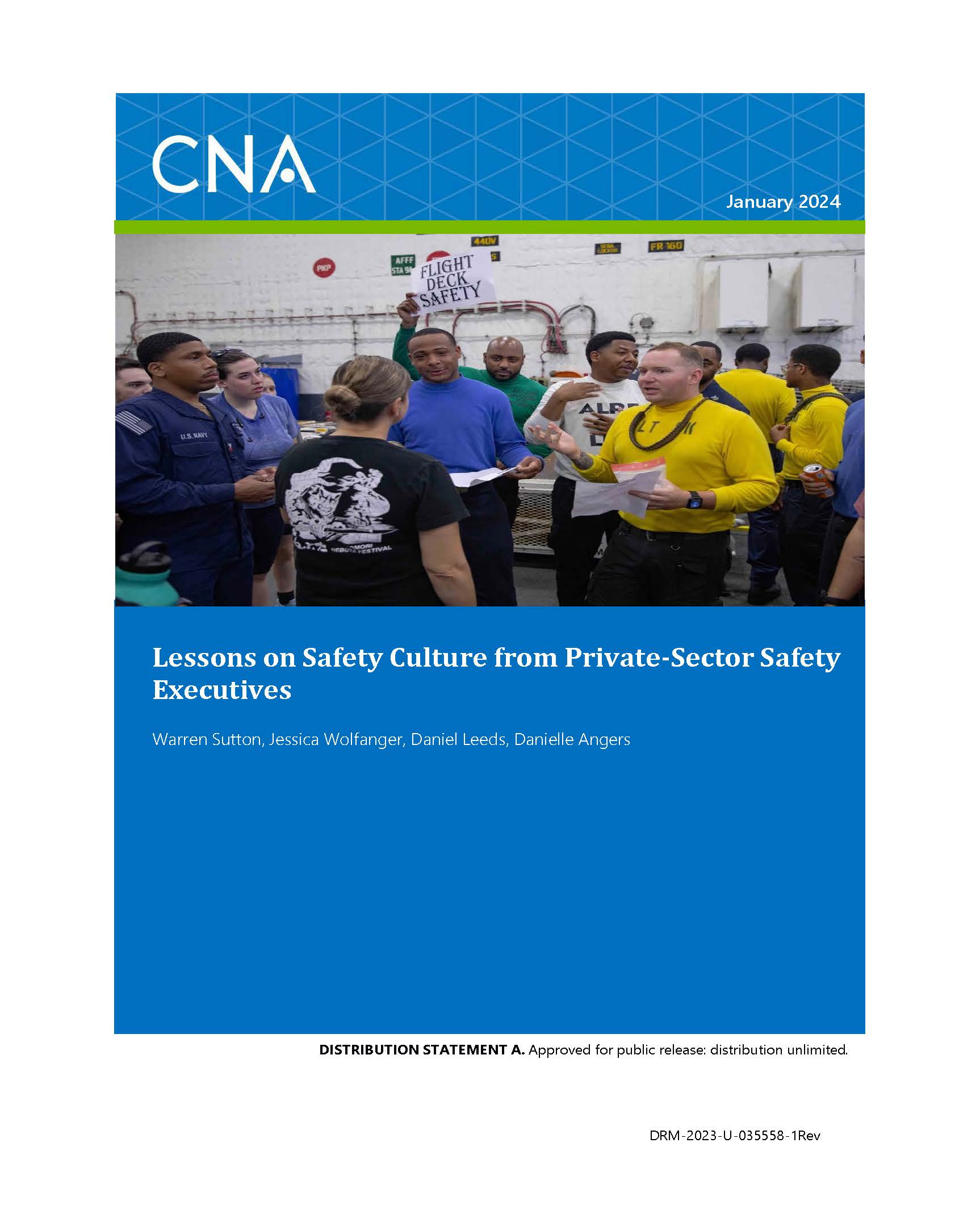The Office of the Assistant Secretary of Defense for Readiness (OASD(R))/Force Safety and Occupational Health (FSOH) asked CNA to gather information from Fortune 1000 companies on the safety policies and practices that contribute to their safety cultures. Specifically, we were asked to hold engagements with C-suite–level executives who manage and oversee large and complex organizations, which is similar to how Office of the Secretary of Defense (OSD) develops policy and oversees Department of Defense (DoD) Component policy implementation. The goal of the study is to provide specific recommendations to OSD based on industry best practices to improve the safety culture within the DoD.
Study approach
To understand how private-sector companies establish and maintain a safety culture, we held C-suite engagements with 21 Fortune magazine–ranked companies. In each engagement, we asked a set of structured questions on the following topics:
- Safety practices: best ways to create and sustain
- Safety metrics: measuring safety outcomes
- Safety policies: defining safety philosophy
- Safety program resourcing
- Voluntary Protection Program (VPP) participation (when applicable).
After hosting the C-suite engagements, we compiled our findings by identifying common themes and novel approaches.
Findings
The following table summarizes our findings and potential leadership actions.
| Finding | Potential leadership action |
|---|---|
| Safety messaging starts with leadership but must be repeated at all levels and in multiple settings | Increase safety engagements during meetings and in overall decision-making |
| Safety is governed at the highest levels of the company; senior executives, making safety a core value | Ensure that safety is governed at the highest levels of DoD and that managers at all levels make safety a core value |
| Safety meetings/trainings are held in conversational forums | Develop a Department-wide Safety Conversation Series |
| Senior management receives safety-specific training | Ensure that new leaders receive rigorous safety- focused training that is periodically refreshed throughout their tenure |
| A successful safety culture empowers employees and incentivizes/rewards reporting safety incidents and hazards | Create an incentive program for safety reporting and reward employees for innovative safety ideas |
| Senior safety executive should be no more than two levels below the top executive | Ensure that safety designees report to the most senior official at every organizational level |
| Regular internal safety audits and evaluations as well as external audits by organizations such as OSHA are required | Require robust audit programs throughout DoD and ensure noncompliance findings are tracked to closure |
| Safety regulators and overseers must have effective methods to assess safety culture | Develop a formal safety culture assessment framework to deploy across DoD |
| OSHA’s VPP is important for establishing and sustaining a strong safety culture | Implement a recognition program like VPP across DoD as part of a comprehensive SMS |
| Track leading indicators | Track leading indicators such as completion of assigned training, work stoppages, near-misses, and ergonomic assessments as well as results of quarterly internal audits to identify hazards and establish remediation plans |
| Senior safety executives receive safety updates/metrics regularly | Ensure that senior leaders receive regular safety updates |
| Technology plays a critical role in reporting | Require electronic data collection and reporting |
| EHS data is collected and reported but not often used for predictive analysis | Incorporate advanced data analytics to forecast safety trends |
| Private-sector entities have access to financial resources necessary to address safety issues; thus, they do not discretely budget for safety |
No specific action can be identified as DoD resourcing differs significantly from private-sector practices. |
DISTRIBUTION STATEMENT A. Approved for public release: distribution unlimited.
Details
- Pages: 46
- Document Number: DRM-2023-U-035558-1Rev
- Publication Date: 1/18/2024
